Realising that the Dalits and the upper castes were upset with its policies, the Bharatiya Janata Party has attempted to take certain corrective measures so as to send a strong signal to various communities. By holding its national executive meeting at the newly constructed Ambedkar International Centre on Janpath, the BJP used symbolism as an endeavour to reach out to the Dalits.
Simultaneously, it was both refreshing to suddenly view, out of the blue Atal Bihari Vajpayee being brought out of the closet to create an impression of a moderate and more tolerant BJP; his posters and hoardings were put up at vantage points of the venue in order to relay an unambiguous message to the Brahmins ahead of the 2019 Parliamentary elections. It is evident that the BJP now is fully aware that it will need more than sheer Modi magic to win back power at the Centre, and therefore this time there is a marked shift in its strategy.
Interestingly, other than Vajpayee, there were posters of top Brahmin leaders such as Murli Manohar Joshi, Sushma Swaraj, Arun Jaitley and Nitin Gadkari prominently displayed on the major thoroughfares of Lutyens’ Delhi as well as that of Rajnath Singh, the most prominent Rajput face of the party. Of course notable patriarch L.K. Advani’s posters were pre-eminent too. There were some pin-ups of the Chief Ministers as well, but none of any known Dalit or Muslim who has served the outfit.
The “Ajey Bharat Atal BJP” slogan given by Narendra Modi was clearly seen as an effort to cash in on Vajpayee’s legacy, aimed at softening a sizable section of the electorate who held the former Prime Minister in high esteem. He virtually had been marginalised and discarded by the party after the 2004 Parliamentary polls, and it was Advani all the way in 2009, and thereafter, Modi. It is another matter, that Advani, Joshi and several important functionaries were sidelined after the spectacular victory of the BJP in 2014. However, since the need of the hour is to flaunt certain faces and images, the party has tactically decided to put them to fore.
The highlight of the National Executive was the BJP’s continued obsession with the Gandhis. Several top leaders, including the Prime Minister, launched a scathing attack on them with the twin objective of tarnishing their perceived failures, while simultaneously setting them up as potential rivals to Modi, who in comparison is a larger than life figure. It is abundantly clear that the BJP would want Rahul Gandhi to be projected as an alternative to Modi in order to triumph in 2019. Although the concept of the Mahagathbandhan (Grand Alliance) was under fire, the Gandhis were singled out for the most vicious and fierce charges.
The assault did not end with the National Executive but even later in the week, Modi struck a chord with several Congress workers, when during an interaction, he noted that in the Congress, unlike in the BJP, the career graph of the activists was solely dependent on how they were assessed by the Gandhi family. It was this perception that determined their destiny and not the hard work they had clocked in over a span of time.
Modi being a seasoned political player knows seamlessly how to capitalise on the sentiments of his adversaries. He is fully mindful of the BJP’s limitations, and thus is conscious of the fact that he needs to demoralise the Congress by either weaning away its workers or its leaders during election time. His Vibhishan strategy reaped rich political dividends in the last Lok Sabha elections, and subsequently in the state polls, where disgruntled Congress leaders and workers contributed to their party’s defeat.
Historically, the Congress has been a party which could not be defeated by its opponents, unless its own rank and file worked along with dissident leaders. In 1977, the Janata Party emerged victorious, only after leading party functionaries, such as Jagjivan Ram, Hemvati Nandan Bahuguna and Nandini Satpathy walked out on Indira Gandhi to form the “Congress for Democracy”. In 1989, the Congress suffered a major setback following the decision of Vishwanath Pratap Singh, Arun Nehru, Mufti Mohammad Sayeed and Arif Mohammad Khan to constitute the “Jan Morcha” to lead to the fall of the grand old party.
In 1996, the Congress (Tewari), created with the blessings of Sonia Gandhi, ensured that P.V. Narasimha Rao did not return to power. In 2014, the resentment of the party workers and the desertion by some leaders who migrated to the BJP for greener pastures proved to be the proverbial last nail in the party’s coffin. Modi skilfully grabbed the headlines by marketing the Congress defeat as his victory. Similar tactics in different states assisted the BJP to come to power. It is a different story that the Congressisation of the BJP has left many its workers disillusioned, but for Modi and Amit Shah, victory is paramount.
Therefore, the reason for Modi perennially striking out at Rahul is to entice the core grassroots workers of the Congress who have become alienated from their leadership due to its excessive dependence on sycophants and middlemen with no political base. Needless to say, the BJP is exhibiting unpalatable arrogance and aggression, which could be detrimental to its future. Currently they are behaving like the Australian cricket team, which despite remaining at the top, lost out, primarily because of its abrasive attitude. Between us.

